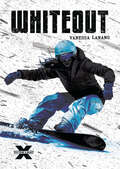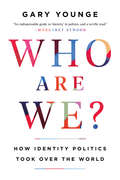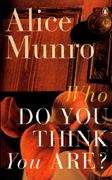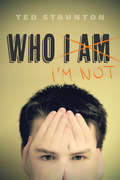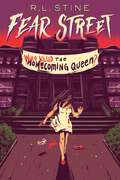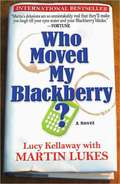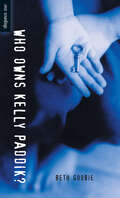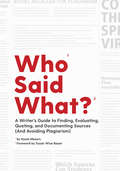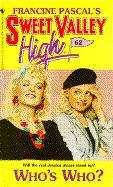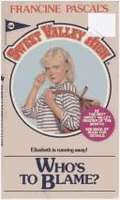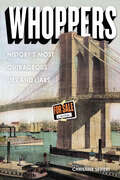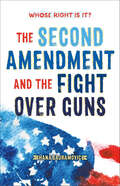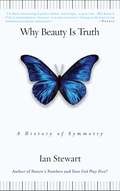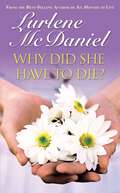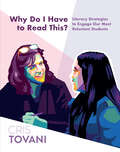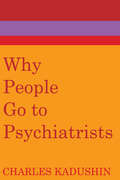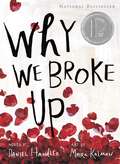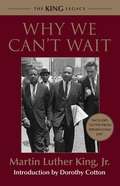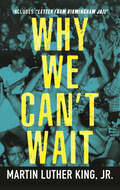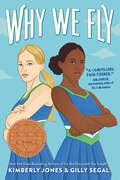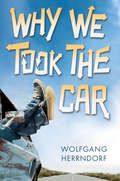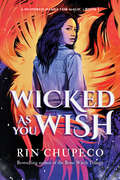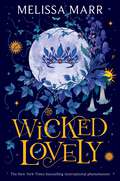- Table View
- List View
Whiteout (To the Limit)
by Vanessa LanangWith dreams of becoming a professional snowboarder on her mind, Jessa drags her younger brother Pax up the tricky slopes of a mountain, ignoring warnings of an approaching storm. She’s having a great time riding the powder—until the storm everybody warned her about gets in the way. Now whiteout conditions make it too dangerous for them to continue. This would-be professional boarder must figure out how to get herself and her younger brother to safety before they both freeze to death.
Who Are We -- And Should It Matter in the 21st Century?: How Identity Politics Took Over The World
by Gary YoungeFrom those who insist that Barack Obama is Muslim to the European legislators who go to extraordinary lengths to ban items of clothing worn by a tiny percentage of their populations, Gary Younge shows, in this fascinating, witty, and provocative examination of the enduring legacy and obsession with identity in politics and everyday life, that how we define ourselves informs every aspect of our social, political, and personal lives.<P> Younge--a black British male of Caribbean descent living in Brooklyn, New York, who speaks fluent Russian and French--travels the planet in search of answers to why identity is so combustible. From Tiger Woods's legacy to the scandal over Danish cartoons of the Prophet Mohammed, he finds that identity is inescapable, but solidarity may not be as elusive as we fear.
Who Do You Think You Are?
by Alice MunroThis book features a set of linked stories that depict the life of a woman maturing from girlhood through adolescence in a small town before eventually leaving. It also offers a picture of adult life away from home, and chronicles the challenges that faced women in the middle of the twentieth century as they balanced traditional gender roles with new professional and sexual possibilities.
Who I'm Not (Young Adult Novels)
by Ted StauntonDanny has survived everything life has thrown at him: being abandoned at birth, multiple abusive foster homes, life as a con man in training. But when his latest "protector" dies suddenly, Danny has to think fast or he'll be back in foster care again. He decides to assume the identity of a boy who disappeared three years before. If nothing else, he figures it will buy him a little time. Much to his astonishment, his new "family" accepts him as their own--despite the fact that he looks nothing like their missing relative. But one old cop has his suspicions about Danny--and he's not about to declare the case closed. Inspired by a true story, Who I'm Not is a powerful portrait of a boy whose identity is as fluid as a river and as changeable as a chameleon's skin.
Who Killed the Homecoming Queen? (Fear Street #48)
by R.L. StineTania is having the best year of her life. She has a hot new boyfriend, she landed the starring role in a student film, and she’s just been voted homecoming queen. But someone is jealous of Tania. Someone plans to ruin her perfect year—even if that means killing her. Will Tania live to see the homecoming dance?
Who Moved My Blackberry?: A Novel
by Lucy KellawayThe television show The Office meets Bridget Jones in a novel set in an office so dysfunctional, it's bound to strike a chord with any nine-to-fiver.A compulsively readable, hilarious novel told through the e-mail messages of Martin Lukes. Martin Lukes is a man who is good at taking credit where it isn't due; a man who works hard at "personal growth" but consistently lets down everyone around him; a man who communicates with his sons by e-mail and fails to notice how smart his wife, Jenny, really is; a man--in short--who loves jargon but totally lacks understanding.
Who Owns Kelly Paddik? (Orca Soundings)
by Beth GoobieKelly Paddik is locked up. Sent to a secure facility because she is a "danger to herself," Kelly wants only to escape. But her painful past continues to haunt her until she is forced to face up to the most painful memory of all. A searing look at one girl's struggle for self respect.
Who Said What? (and Avoiding Plagiarism): A Writer's Guide To Finding, Quoting, And Documenting Sources (and Avoiding Plagiarism)
by Kayla MeyersA thorough, accessible guide to research, citation, and source evaluation, designed to assist students growing up in an era of social media, fake news, alternative facts, and information overload. Is Yahoo Answers a good source for your History essay? How about InfoWars? How do you include another person’s ideas in your work without stealing them? Should you cite an Instagram post as a source, and if so, how do you do it? Who Said What? provides students from middle school through college (along with bloggers, writers, and others who need to write with accuracy and clarity) with a reliable, friendly guide through the often bewildering process of research, writing, and documentation. Drawing on years of teaching, research, and writing experience, Kayla Meyers teaches you how to evaluate the trustworthiness of a source, how to use it without stealing it, how to properly credit its creator, and why all of this even matters. With contemporary examples and the step-by-step explanations that made Susan Wise Bauer’s Writing With Skill series so popular, Who Said What? will become an essential resource for young writers.
Who's Who (Sweet Valley High #62)
by Francine Pascal Kate WilliamsJessica signs up with a dating service -- twice -- once under the name Daniella Fromage and again as Magenta Galaxy. She then coerces Elizabeth to take over one of the characters when she schedules two dates for one night. Who has met her match -- Daniella, Magenta ... or Jessica?
Who's to Blame? (Sweet Valley High #66)
by Francine Pascal Kate WilliamElizabeth and Jessica's parents are separated. Jessica realizes that it is her fault that her parents are no longer together, so she is going to be out of their way.
Whoppers: History's Most Outrageous Lies and Liars
by Christine SeifertHistory of full of liars. Not just little-white-telling liars, but big-honkin', whopper-telling liars—people who can convince us that even the most improbable, outrageous, nonsensical stories are true. And the worst part is that we'll believe it. Whoppers tells the story of history's greatest liars and the lies they told, providing a mix of narrative profiles of super-famous liars, lies, and/or hoaxes, as well as more obscure episodes. Famous liars include people you might have learned about in school, like P. T. Barnum, who basically made a living lying to people for money; liars you might never have heard of before, like Victor Lustig, who managed to "sell" the Eiffel Tower twice in the 1920s; and hoaxes like the Loch Ness Monster Photo Hoax. The book will also include illustrations, sidebars, and infographics.
Whose Right Is It? The Second Amendment and the Fight Over Guns
by Hana BajramovicDiscover the truth about the Second Amendment, the NRA, and the United States’ centuries-long fight over guns in this first-of-its-kind book for middle grade readers."A compelling, clear analysis of one of our country’s oldest dilemmas: how to balance gun rights with public safety. It tells the full and true story of the Second Amendment, and points to a way to bring sanity to our gun laws. A remarkable primer for all ages." —Michael Waldman, author of The Second Amendment: A Biography For the majority of the United States’ history, the right to own a gun belonged to a “well regulated militia.” That changed in 2008 with the historic District of Columbia v. Heller case, which ruled that the Second Amendment protected an individual’s right. In the years since, the debate over gun legislation has reached a crescendo. And the issue grows ever relevant to children across America, with an estimated three million exposed to shootings every year. From metal detectors to see-through backpacks to shooting drills, kids face daily reminders of the threat of guns. Hana Bajramovic's Whose Right Is It? The Second Amendment and the Fight Over Guns reveals how a once obscure amendment became the focus of daily heated debate. Filled with historical photos and informative graphics, the book will show young readers how gun legislation has always been a part of American history and how money, power, and systemic racism have long dictated our ability to own guns.A Junior Library Guild Selection"Hana Bajramovic provides readers with a compelling overview on the history of guns in the United States and the changing, conflicting interpretations of the Second Amendment certain to stimulate conversation and thinking on the part of future generations." —Award-winning author Doreen Rappaport
Why Afterschool Matters
by Ingrid A. NelsonIncreasingly, educational researchers and policy-makers are finding that extracurricular programs make a major difference in the lives of disadvantaged youth, helping to reduce the infamous academic attainment gap between white students and their black and Latino peers. Yet studies of these programs typically focus on how they improve the average academic performance of their participants, paying little attention to individual variation. Why Afterschool Matters takes a different approach, closely following ten Mexican American students who attended the same extracurricular program in California, then chronicling its long-term effects on their lives, from eighth grade to early adulthood. Discovering that participation in the program was life-changing for some students, yet had only a minimal impact on others, sociologist Ingrid A. Nelson investigates the factors behind these very different outcomes. Her research reveals that while afterschool initiatives are important, they are only one component in a complex network of school, family, community, and peer interactions that influence the educational achievement of disadvantaged students. Through its detailed case studies of individual students, this book brings to life the challenges marginalized youth en route to college face when navigating the intersections of various home, school, and community spheres. Why Afterschool Matters may focus on a single program, but its findings have major implications for education policy nationwide.
Why Beauty is Truth: The History of Symmetry
by Ian StewartAt the heart of relativity theory, quantum mechanics, string theory, and much of modern cosmology lies one concept: symmetry. <P><P> In Why Beauty Is Truth, world-famous mathematician Ian Stewart narrates the history of the emergence of this remarkable area of study. Stewart introduces us to such characters as the Renaissance Italian genius, rogue, scholar, and gambler Girolamo Cardano, who stole the modern method of solving cubic equations and published it in the first important book on algebra, and the young revolutionary Evariste Galois, who refashioned the whole of mathematics and founded the field of group theory only to die in a pointless duel over a woman before his work was published. Stewart also explores the strange numerology of real mathematics, in which particular numbers have unique and unpredictable properties related to symmetry. He shows how Wilhelm Killing discovered "Lie groups" with 14, 52, 78, 133, and 248 dimensions-groups whose very existence is a profound puzzle. Finally, Stewart describes the world beyond superstrings: the "octonionic" symmetries that may explain the very existence of the universe.
Why Did She Have to Die? (Lurlene McDaniel Books)
by Lurlene N. McDanielFor thirteen years, Elly has been in Kathy's shadow, always second best. Even so, the two of them understand each other as only sisters can. Jealousy, anger, and resentment give way to guilt when Kathy dies suddenly and Elly is left to ask, "Why did she have to die?"
Why Do I Have to Read This?: Literacy Strategies to Engage Our Most Reluctant Students
by Cris TovaniWhy do I have to read this?- What teacher doesn't dread this question? It usually comes from our most disengaged students a student who cries of boredom, or one who is angry or apathetic. When we don't know what else to try, it's easy to become frustrated and give up on these challenging learners. Author Cris Tovani has spent her career figuring out how to entice challenging students back into the process of learning. Why Do I Have to Read This?: Literacy Strategies to Engage our Most Reluctant Students Tovani shares her best secrets, lessons learned from big fails, and her most effective literacy and planning strategies that hook these hard to get learners. You will meet many of Tovani's students inside this book. As she describes some of her favorites, you may even recognize a few of your own. You will laugh at her stories and take comfort in her easily adaptable strategies that help students remove their masks of disengagement. She shows teachers how to plan by anticipating students' needs. HerC urriculumY ouA nticipate structures of Topic, Task, Targets, Text, Tend to me, and Time willhelp you anticipate your curriculum. InsideWhy Do I Have to Read This? readers will find: Literacy strategies for all content areas that support and engage a wide range of learners so they can read and write a variety of complex textReference charts packed with small bites of instructional shifts that coaches and teachers can use to quickly adjust instruction to re-engage studentsPlanning strategies that show teachers how to connect day-to-day instruction so that no day lives in isolationVersatile think sheets that are reproducible and adaptable to different grade levels, content areas, and disciplinesAbove all, Tovani gives teachers energy to get back into the classroom and face students who wear masks of disengagement. She reminds us of the importance of connecting students to compelling topics, rich text, useful targets, and worthy tasks. Teachers must tendto students' basic needs and helps us consider how to best structure instructional time.After reading this book, teachers will have new ways to connect with students in a deep, authentic way. Written in a humorous, compassionate, and wise voice,Why Do I Have to Read This? will provide answers to the pressing questions we have when we try to teach and reach all of our students.
Why People Go to Psychiatrists
by Charles KadushinThis is the first examination in depth of the reasons and ways that people seek psychiatric help. Viewing contemporary metropolitan life from the standpoint of an experienced social analyst, Charles Kadushin deals with such issues as, why people believe they have emotional problems, what types of problems send them to psychiatrists, how, why, and by whom potential patients are told they are disturbed, why people choose psychiatry over other healing methods, and why many people do not receive treatment from the sources to which they apply.The author develops a new theory of social circles, describing how people move in a network of friends and acquaintances with varying degrees of knowledge of and interest in psychiatry. This factor affects decisions to obtain professional help and also has bearing on the types of problems presented. The study encompasses a wide variety of persons in a complex community environment--New York City, the psychotherapy capital of the world. The basic data were obtained from 1,500 patients in ten psychiatric clinics in three major treatment areas medical, analytic, and religio-psychiatric.The book provides new insights into the motivations of the patients as well as information about their social setting. It is an informative and engrossing work for students and scholars; for sociologists in the areas of medicine and mental health; for psychiatrists, clinical psychologists, and social workers actively engaged in treatment and casework; and for all professionals in the community health field.
Why We Broke Up
by Maira Kalman Daniel HandlerI'm telling you why we broke up, Ed. I'm writing it in this letter, the whole truth of why it happened.Min Green and Ed Slaterton are breaking up, so Min is writing Ed a letter and giving him a box. Inside the box is why they broke up. Two bottle caps, a movie ticket, a folded note, a box of matches, a protractor, books, a toy truck, a pair of ugly earrings, a comb from a motel room, and every other item collected over the course of a giddy, intimate, heartbreaking relationship. Item after item is illustrated and accounted for, and then the box, like a girlfriend, will be dumped.
Why We Can't Wait
by Martin Luther King Jr.Dr. King's best-selling account of the civil rights movement in Birmingham during the spring and summer of 1963. In 1963, Birmingham, Alabama, was perhaps the most racially segregated city in the United States, but the campaign launched by Fred Shuttlesworth, Dr. Martin Luther King, Jr., and others demonstrated to the world the power of nonviolent direct action. Often applauded as King's most incisive and eloquent book,Why We Can't Wait recounts the Birmingham campaign in vivid detail, while underscoring why 1963 was such a crucial year for the civil rights movement. King examines the history of the civil rights struggle and the tasks that future generations must accomplish to bring about full equality. The book also includes the extraordinary Letter from Birmingham Jail which King wrote in April of 1963.
Why We Can't Wait: Why We Can't Wait (King Legacy #4)
by Martin Luther KingDr. King's best-selling account of the civil rights movement in Birmingham during the spring and summer of 1963 In 1963, Birmingham, Alabama, was perhaps the most racially segregated city in the United States, but the campaign launched by Fred Shuttlesworth, Dr. Martin Luther King, Jr., and others demonstrated to the world the power of nonviolent direct action. Often applauded as King's most incisive and eloquent book, Why We Can't Wait recounts the Birmingham campaign in vivid detail, while underscoring why 1963 was such a crucial year for the civil rights movement. King examines the history of the civil rights struggle and the tasks that future generations must accomplish to bring about full equality. The book also includes the extraordinary "Letter from Birmingham Jail," which King wrote in April of 1963.
Why We Fly
by Gilly Segal Kimberly JonesFrom the New York Times bestselling authors of I'm Not Dying with You Tonight comes a story about friendship, privilege, sports, and protest.With a rocky start to senior year, cheerleaders and lifelong best friends Eleanor and Chanel have a lot on their minds. Eleanor is still in physical therapy months after a serious concussion from a failed cheer stunt. Chanel starts making questionable decisions to deal with the mounting pressure of college applications. But they have each other's backs—just as always, until Eleanor's new relationship with star quarterback Three starts a rift between them.Then, the cheer squad decides to take a knee at the season's first football game, and what seemed like a positive show of solidarity suddenly shines a national spotlight on the team—and becomes the reason for a larger fallout between the girls. As Eleanor and Chanel grapple with the weight of the consequences as well as their own problems, can the girls rely on the friendship they've always shared?Praise for I'm Not Dying with You Tonight:A Barnes & Noble Book Club Pick"Compelling and powerful"—Angie Thomas, #1 New York Times bestselling author of The Hate U Give"A vital addition to the YA race relations canon."—Nic Stone, New York Times bestselling author of Dear Martin"Important reading for both teenagers and adults."—Hello Giggles"Not to be missed."—Paste Magazine
Why We Took the Car
by Wolfgang HerrndorfA beautifully written, darkly funny coming-of-age story from an award-winning, bestselling German author making his American debut.Mike Klingenberg doesn't get why people think he's boring. Sure, he doesn't have many friends. (Okay, zero friends.) And everyone laughs at him when he reads his essays out loud in class. And he's never invited to parties - including the gorgeous Tatiana's party of the year.Andre Tschichatschow, aka Tschick (not even the teachers can pronounce his name), is new in school, and a whole different kind of unpopular. He always looks like he's just been in a fight, his clothes are tragic, and he never talks to anyone.But one day Tschick shows up at Mike's house out of the blue. Turns out he wasn't invited to Tatiana's party either, and he's ready to do something about it. Forget the popular kids: Together, Mike and Tschick are heading out on a road trip. No parents, no map, no destination. Will they get hopelessly lost in the middle of nowhere? Probably. Will meet some crazy people and get into serious trouble? Definitely. But will they ever be called boring again? Not a chance.
Wicked As You Wish (A Hundred Names for Magic #1)
by Rin ChupecoAn unforgettable alternative history fairytale series from the author of The Bone Witch trilogy about found family, modern day magic, and finding the place you belong. <p><p> Many years ago, the magical Kingdom of Avalon was left desolate and encased in ice when the evil Snow Queen waged war on the powerful country. Its former citizens are now refugees in a world mostly devoid of magic. Which is why the crown prince and his protectors are stuck in...Arizona. <p> Prince Alexei, the sole survivor of the Avalon royal family, is in hiding in a town so boring, magic doesn't even work there. Few know his secret identity, but his friend Tala is one of them. Tala doesn't mind—she has secrets of her own. Namely, that she's a spellbreaker, someone who negates magic. <p> Then hope for their abandoned homeland reignites when a famous creature of legend, and Avalon's most powerful weapon, the Firebird, appears for the first time in decades. Alex and Tala unite with a ragtag group of new friends to journey back to Avalon for a showdown that will change the world as they know it.
Wicked Lovely (Wicked Lovely #1)
by Melissa MarrFans of Sarah J. Maas and Holly Black won’t be able to resist the world of Melissa Marr's #1 New York Times bestselling series, full of faerie intrigue, mortal love, and courtly betrayal.Rule #3: Don't stare at invisible faeries.Aislinn has always seen faeries. Powerful and dangerous, they walk hidden in mortal world. Aislinn fears their cruelty—especially if they learn of her Sight—and wishes she were as blind to their presence as other teens.Rule #2: Don't speak to invisible faeries.Now faeries are stalking her. One of them, Keenan, who is equal parts terrifying and alluring, is trying to talk to her, asking questions Aislinn is afraid to answer.Rule #1: Don't ever attract their attention.But it's too late. Keenan is the Summer King who has sought his queen for nine centuries. Without her, summer itself will perish. He is determined that Aislinn will become the Summer Queen at any cost—regardless of her plans or desires.Suddenly none of the rules that have kept Aislinn safe are working anymore, and everything is on the line: her freedom, her best friend Seth, her life—everything.
